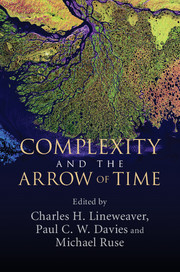Book contents
- Frontmatter
- Contents
- Author biographies
- Part I Introduction
- Part II Cosmological and physical perspectives
- 2 Directionality principles from cancer to cosmology
- 3 A simple treatment of complexity: cosmological entropic boundary conditions on increasing complexity
- 4 Using complexity science to search for unity in the natural sciences
- 5 On the spontaneous generation of complexity in the universe
- 6 Emergent spatiotemporal complexity in field theory
- Part III Biological complexity, evolution, and information
- Part IV Philosophical perspectives
- Index
- References
5 - On the spontaneous generation of complexity in the universe
from Part II - Cosmological and physical perspectives
Published online by Cambridge University Press: 05 July 2013
- Frontmatter
- Contents
- Author biographies
- Part I Introduction
- Part II Cosmological and physical perspectives
- 2 Directionality principles from cancer to cosmology
- 3 A simple treatment of complexity: cosmological entropic boundary conditions on increasing complexity
- 4 Using complexity science to search for unity in the natural sciences
- 5 On the spontaneous generation of complexity in the universe
- 6 Emergent spatiotemporal complexity in field theory
- Part III Biological complexity, evolution, and information
- Part IV Philosophical perspectives
- Index
- References
Summary
A glance out the window confirms that the universe is complex. By day, intricate weather patterns chase the Sun along its path. At night, galaxies, stars, and planets wheel across the sky. Rabbits hop across the lawn, pursued by coyotes. Trucks rumble along the highway. Turning one's gaze inside the room confirms the diagnosis. People chat and argue. Children grow. Food cooks on the stove. Spam accumulates in the computer inbox.
How and why did all this complexity come about? The answers that we currently possess are largely qualitative and historical. The big bang happened, gravitational instability made matter clump together, stars started to shine, planets formed, life began, humans showed up, societies formed, all hell broke loose. We know that the universe is complex, and we know something of the sequence in which more and more complex systems developed. It would be good, however, to know WHY the universe is complex. Is there some intrinsic drive to the creation of complexity in matter and energy? Are there other universes, and if so, are they more or less complex than ours? Will this generation of complexity go on for ever?
- Type
- Chapter
- Information
- Complexity and the Arrow of Time , pp. 80 - 112Publisher: Cambridge University PressPrint publication year: 2013
References
- 6
- Cited by



